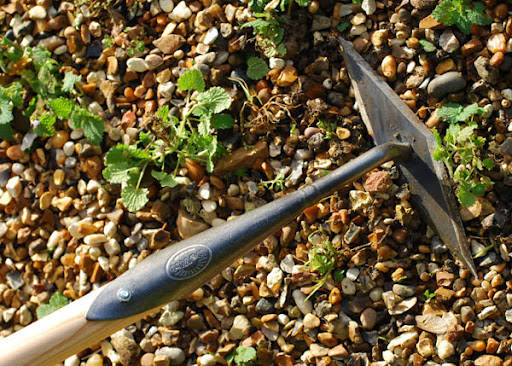Controlling weeds in Las Vegas take persistent work
Weeds are great competitors. They are the first to invade empty spaces, pushing more valuable plants to the side, growing between plants or smothering them with their growth.
The three worst weeds to control in home landscapes are common Bermuda grass, nutgrass and palm seedlings. Controlling common Bermuda grass and nutgrass organically requires persistence — knocking them back as soon as they appear until they finally start surrendering around late summer. Yes, eventually their population starts to decrease if you consistently knock them back time and time again.
Palm seedlings are probably the easiest to control. There are just so many of them, and that makes it difficult. One strong tug on them when 10 inches tall and the soil is wet pulls them from the soil.
Give them a squirt of water when you see them and pull. When they are smaller or bigger than 10 inches, pulling is more difficult. But unlike Bermuda and nutgrass, once they are gone, they are gone until the next seedling grows.
Pruning palm trees at the end of April each year removes flower stalks and prevents problem seedlings from starting in the first place.
Weeds fall into two categories: annuals that grow from seed every year and perennials that grow every year from plant parts buried in the soil. Most problem weeds in fresh soil are annuals.
A prime example of a winter annual weed is the spicy, edible mustards seen dark green in December and with small yellow flowers in the spring when ready to spit their seed. They are easy to kill and never come back until November if eliminated one month later in December before they flower.
Winter annual weeds provide a haven for spring plant pests like aphids if left uncontrolled. Weed control during December and early January is essential if you want fewer insect pests attacking your plants in the spring.
Spraying trees and shrubs with dormant oil in late fall and winter knocks them down, or burn any weeds growing with a hula or stirrup hoe or flame weeder.
Q: I am having difficulty controlling Bermuda grass. I used the flame weeder you recommended, but it grows back with a vengeance. What am I doing wrong?
A: You aren’t doing anything wrong. That’s exactly what happens when you first start killing the tops of perennial weeds like Bermuda grass. Flame or fire weeders burn the tops of weeds to the ground if held there long enough. When the tops of perennial weeds are killed, the new below-ground buds, under the dead tops, begin to grow.
For each top burned back, several new buds grow to replace the dead one. That’s normal. Weeds come back with a vengeance when first killed.
The good news is if you burn the tops down over and over when they’re small, less new growth occurs after the third or fourth time they die.
Perennial weeds like Bermuda grass invest food and energy from their roots into the new growth until it’s about 4 inches tall. After about 4 inches, they start replacing their investment. If you wait too long, you must start again killing a fresh plant, and nothing was gained.
Let Bermuda grass invest in this new growth. Then burn it back and take away its investment.
Killing the tops when they’re small, eventually taking this investment away, over and over, weakens it and you begin winning this war of attrition. Weed killers and hoes do the same thing as fire if the new growth is killed as soon as it is seen.
Q: I would like to buy a small amount of Fusilade weed killer. I see it’s very expensive to buy online. Where can I buy a small amount of it? I don’t need much.
A: Sorry, buying a small amount can’t be done. Fusilade is a chemical weed killer that kills grasses without hurting ornamental plants. In other words, it can be used to kill grasses growing together with ornamental flowers and other ornamental plants without damaging the flowers or the plant.
It is only available as Fusilade. If you want to use this product, then find the best price and buy it. Legally it can’t be bought from another person in small quantities from opened containers, so I can’t recommend doing that.
Other products can be used by homeowners, available in smaller amounts, and they do about the same thing. These products contain an active ingredient called Sethoydim and are found under the trade names like Grass Killer, Over the Top and others. As always, follow the labeled directions for the best results.
Look for these products if you are trying to kill Bermuda grass growing around ornamental plants.
Q: I applied a “weed and feed” fertilizer to my lawn this spring with no results. It didn’t work. What happened?
A: Weed and feed fertilizers come in two different basic types: One is a weed and feed that must be applied when the weeds are growing, and the other weed and feed is applied to prevent weeds from growing. Make sure you buy and apply the correct weed and feed to your lawn for the right reason.
Weed and feed fertilizers made to control existing weeds contain post-emergent weed killers like Trimec, 2,4-D, dicamba or MCPP. These weed and feed fertilizers are for existing weeds such as dandelions, oxalis, clover, chickweed and others.
First, turn on the sprinklers and lightly wet the grass. Then apply the weed and feed fertilizer to the wet lawn (and weeds).
It should not be applied during the hot days of summer. Best control of weeds with chemicals happens during the spring and fall months when it is cooler. Don’t irrigate for 24 hours after it’s applied, or you will wash the weed killers from the weeds. Read the directions carefully before applying it.
The other weed and feed fertilizer is usually applied in February to control the future growth of crabgrass, spurge and other annual weeds. This type of weed and feed fertilizer relies on establishing an unbroken barrier pre-emergent weed killer that kills the seed of this weed as it’s germinating.
It’s very important that the lawn (and the barrier) is not disturbed after it is applied. Read the directions carefully.
Weeds in lawns are caused by three things: mowing the lawn too short, edging the lawn with a line trimmer held at an angle and not cleaning mowers between lawns. About 98 percent of the lawns grown here are tall fescue, a cool-season grass that should stay green all winter long and through the summer.
Tall fescue lawns must be mowed between 2 and 3 inches in height. Most of the lawns I see are mowed less than 1.5 inches tall. If you want to know what height your lawn is mowed at, measure the height of the lawn using a plastic ruler the day it is mowed. If it’s not at least 2 inches in height, raise the mowing height.
Use a steel edger when edging a lawn, not a line trimmer. If a line trimmer must be used, don’t finish the edging by cutting the grass at an angle.
Steel edgers must be held perpendicular to the lawn. Making what I call a bevel cut results in a very short lawn at the edges. This short grass results in lawn weeds invading the lawn from these short edges.
Have your maintenance company clean the mowers before they cut your lawn. Too many times weed seeds and lawn diseases are carried from one lawn to another on dirty mowers.
Q: You mentioned that a weed barrier was not necessary when applying 4 inches of surface mulch like rock. On a recent landscape planting I followed your advice and now have weeds growing where they planted the shrubs.
A: You would have weeds growing around the plants regardless of whether a weed barrier is used or not. Weeds occur naturally when soil is disturbed, the barrier is cut and there is irrigation.
A 3- to 4-inch barrier of mulch (rock or wood chips on the soil surface) is thick enough to stop most weeds except Bermuda grass and nutgrass. It’s a weed barrier.
Weeds like common Bermuda grass and nutgrass grow wherever there is water and through every type of weed barrier. Both thick mulch and weed barriers will not stop these weeds.
Hand pull or hoe weeds growing close to your ornamental trees and shrubs. If you do this regularly, they will stop growing there. Use Fusilade or Poast (weed killer) to kill grassy weeds such as common Bermuda grass growing near your ornamental plants.
Bob Morris is a horticulture expert and professor emeritus of the University of Nevada, Las Vegas. Visit his blog at xtremehorticulture.blogspot.com. Send questions to Extremehort@aol.com.























